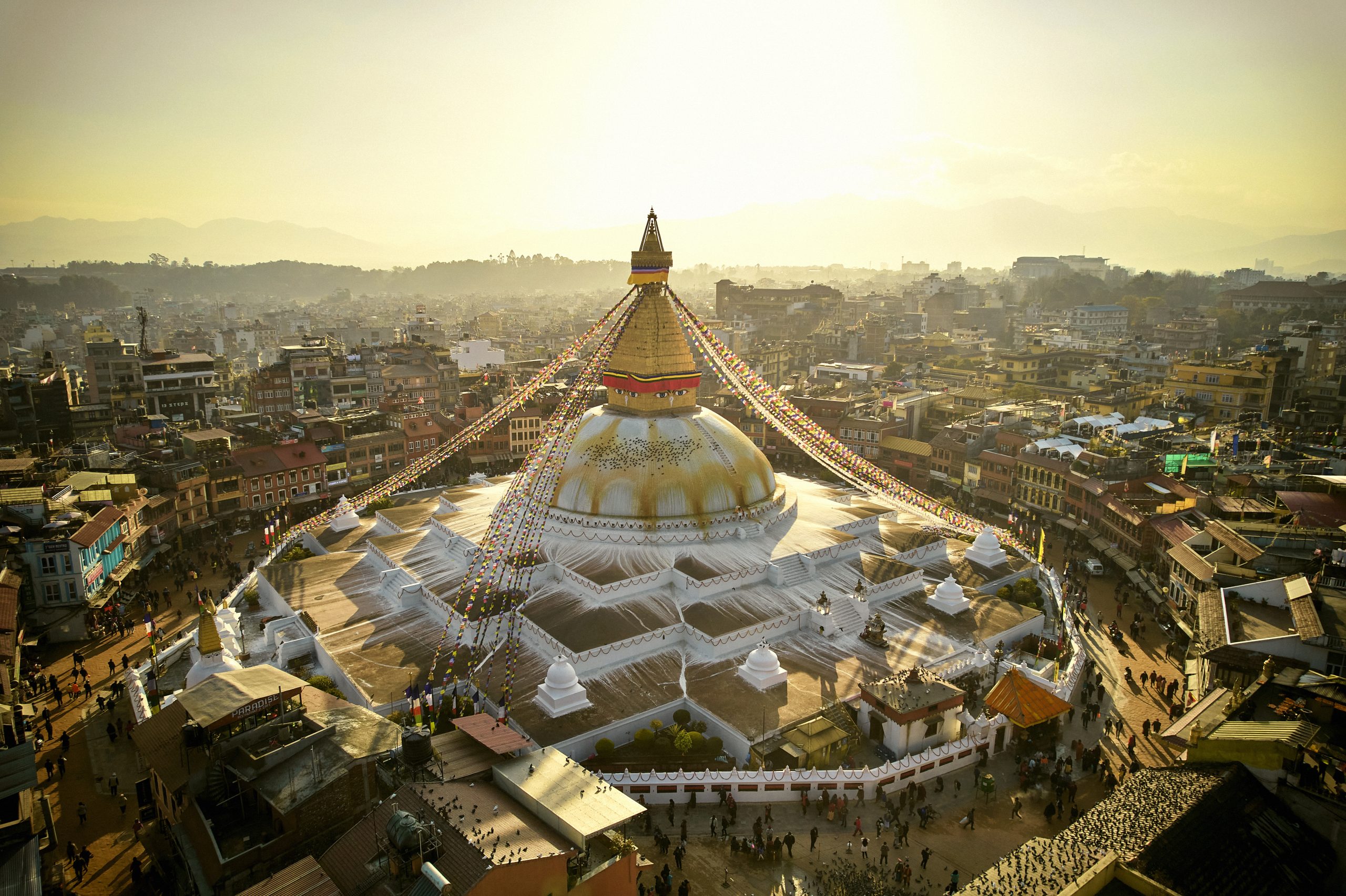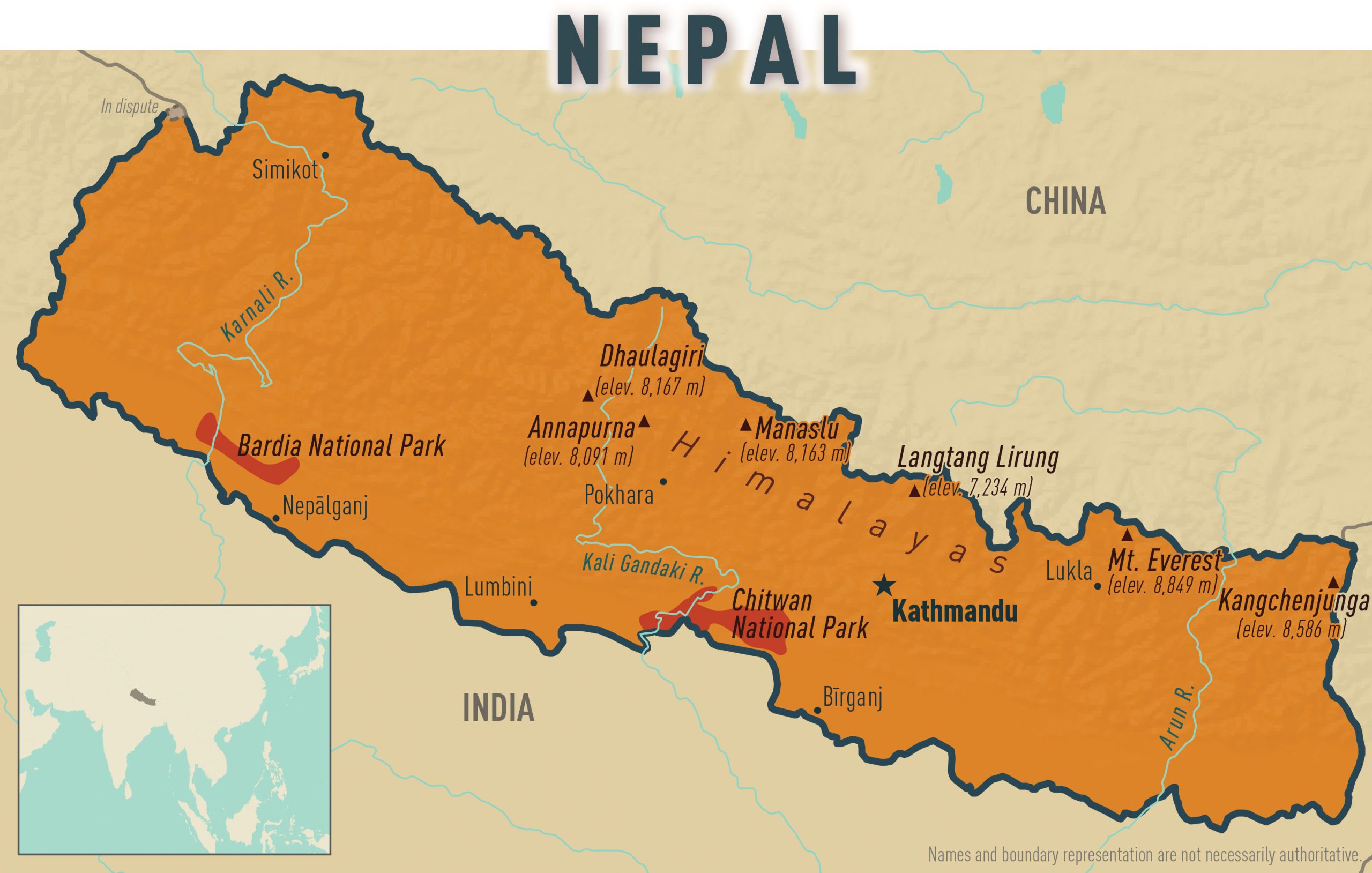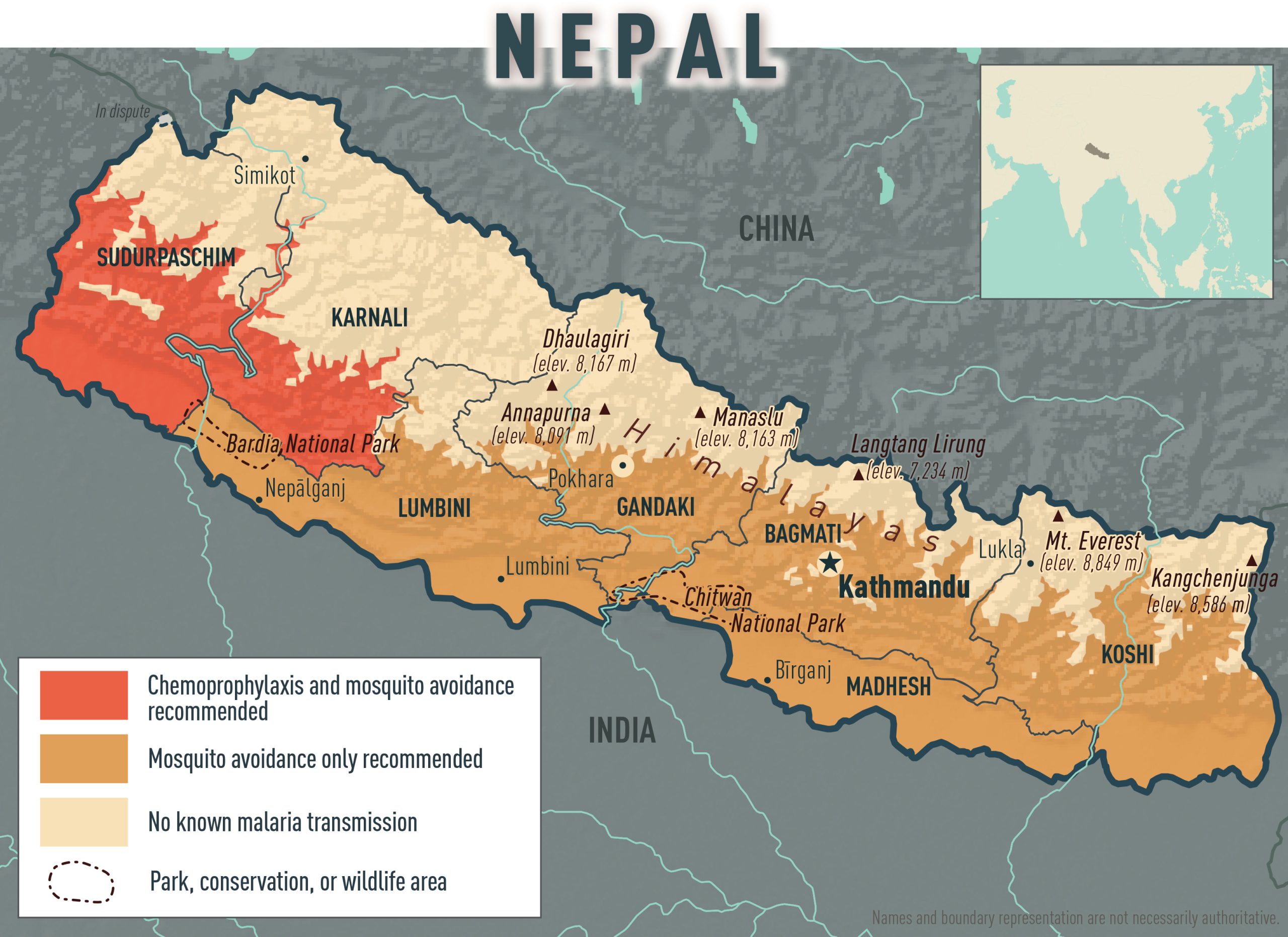Purpose

Destination overview
Home to >30 million people, Nepal stretches for 805 km (500 miles) along the Himalayan mountains that form its natural border with China (Map 11.3.3.1). The topography rises from low plains at 70 m (230 ft) elevation to the highest point in the world at 8,848 m (29,029 ft), the summit of Mount Everest. Kathmandu, the capital city with a population of >2 million people, sits in a lush valley at 1,324 m (4,344 ft) elevation.
Nepal's latitude of 28°N (the same as Florida) means that its non-mountainous areas are temperate year-round. Most annual rainfall comes during the monsoon season (June–September). The main tourist seasons are the spring (March–May) and fall (October–November). The winter months, December–February, are pleasant in the lowlands but can be too cold to make trekking enjoyable in the high mountains.
Approximately 30% of travelers to Nepal go to trek into the mountains; others go to experience the country's culture and stunning natural beauty. Lumbini, in the Terai region, is the birthplace of the Buddha and has become an increasingly popular and beautifully developed pilgrimage destination for Buddhists from around the world. There is now an international airport, called Gautam Buddha International Airport, near Lumbini, with direct flights from other Asian countries.
Nepal was once considered the most roadless country in the world, but in the last two decades roads have been constructed throughout the country. The roads have significantly changed the trekking experience. Roads have increased the ease of access to some places while destroying the ambience of other famous treks. The roads, of course, are desirable to local people who would want to travel from their villages to Kathmandu without walking for a week or longer.
In addition to trekking through the mountains, Nepal has some of the best rafting and kayaking rivers in the world. Jungle lodges in Chitwan National Park allow visitors to see a wide range of wildlife, including crocodiles, rhinoceros, tigers, and a variety of exotic birds. Less adventurous travelers can drive to comfortable hotels offering commanding views of the Himalayas, both near Kathmandu and near Pokhara. Plans are underway to receive international flights at Pokhara Airport, giving visitors more options for traveling in and out of Nepal.
Map 11.3.3.1

Centers for Disease Control and Prevention
Infectious disease risks
Enteric infections and diseases
Travelers to Nepal are at high risk for enteric diseases. Hepatitis A vaccine and typhoid vaccine are the 2 most important pre-travel immunizations. The risk for typhoid fever and paratyphoid fever among visitors to Nepal is among the highest in the world, and the prevalence of fluoroquinolone resistance also is high (see Typhoid and Paratyphoid Fever chapter). Tap water in Nepal is not considered safe for drinking, and travelers should only drink boiled or bottled water (see Food and Water Precautions for Travelers and Water Disinfection for Travelers chapters).
Cyclosporiasis
Cyclospora cayetanensis, an intestinal protozoal pathogen, is highly endemic to Nepal. Risk for infection is distinctly seasonal; transmission occurs almost exclusively during May–October, with a peak in June and July. Because transmission occurs outside the main tourist seasons, cyclosporiasis primarily affects expatriates who stay through the monsoon. In addition to watery diarrhea, profound anorexia and fatigue are the hallmark symptoms of Cyclospora infection. The treatment of choice is trimethoprim-sulfamethoxazole. No highly effective alternative drugs have been identified.
Hepatitis E
Hepatitis E virus is endemic in Nepal, and several cases each year are diagnosed in visitors or expatriates. No vaccine against hepatitis E is commercially available; travelers should follow safe food and water precautions. Although the risk is small statistically, hepatitis E infection that occurs during pregnancy can be devastating, with both fetal and maternal mortality. Pregnant travelers should be advised of this potential risk before traveling to Nepal.
Travelers' diarrhea
Travelers' diarrhea is a risk, and the risk during the spring trekking season (March–May) is double that of the fall trekking season (October–November). Because many travelers head to remote areas that do not have available medical care, they should be provided with medications for self-treatment (see Travelers' Diarrhea chapter). Extensive resistance to fluoroquinolones has been documented among bacterial diarrheal pathogens in Nepal, and azithromycin is considered the empiric drug of choice.
Respiratory infections and diseases
Respiratory illnesses among travelers are common, both in Kathmandu and on trekking routes. The advent of COVID-19 makes it more difficult to assume the etiology of a respiratory infection. Prolonged symptoms beyond 7–10 days often require a medical assessment (see Post-Travel Respiratory Infections chapter).
Coronavirus disease 2019
All travelers going to Nepal should be up to date with their COVID-19 vaccines (see COVID-19 chapter).
Influenza
Influenza is a risk in Nepal, particularly in crowded teahouses at higher elevations (see Influenza chapter). Trekkers should receive a current influenza immunization before travel.
Tuberculosis
Tuberculosis disease that exists among local people can be due to drug-resistant strains of Mycobacterium tuberculosis (see Tuberculosis chapter). Both multidrug-resistant and extensively drug-resistant tuberculosis have been reported in Nepal. Overall, however, risk to travelers is low.
Vector-borne diseases
Dengue
In 2019, the Ministry of Health in Nepal reported approximately 18,000 cases of dengue, and in 2022, greater than 46,000 cases (see Dengue chapter). Counsel all travelers going to Nepal during the warmer, wetter months to pack a U.S. Environmental Protection Agency (EPA)-registered insect repellent in their travel health kit and to practice insect-bite precautions (see Travel Health Kits and Mosquitoes, Ticks, and Other Arthropods chapters).
Japanese encephalitis
Japanese encephalitis (JE) is endemic to Nepal (see Japanese Encephalitis chapter); the greatest disease risk is in the Terai region during and immediately after monsoon season (June–October). JE has been identified in local residents of the Kathmandu Valley, but only 1 case of JE acquired in Nepal has been reported in a foreign traveler, a tourist who spent time in the Terai region in August. JE vaccine is not routinely recommended for people trekking to higher elevation areas or spending short periods in Kathmandu or Pokhara en route to such treks. JE vaccine is recommended for all expatriates living in Nepal.
Malaria
Although targeted for complete elimination of malaria by 2020, Nepal continues to report low (and decreasing) numbers of indigenous cases, primarily Plasmodium vivax (see Yellow Fever Vaccine and Malaria Prevention Information, by Country and Malaria chapters; and Map 1.5.33). The World Health Organization reported only 36 cases in the whole country in 2022, down from over 2,000 a decade before. Although the vector for malaria can exist at altitudes below 2,000 meters (6,500 feet), the risk of malaria is limited to remote parts of Nepal rarely visited by tourists. In 40 years of monitoring by the main clinic that cares for foreigners in Nepal, there have been fewer than 5 cases, all from remote areas that tourists almost never visit. CDC recommends chemoprophylaxis with atovaquone-proguanil, doxycycline, mefloquine, or tafenoquine only for travel to areas <2,000 m in Sudurpashchim or Kernali Provinces. There is no malaria transmission in Kathmandu, in Pokhara, or while traveling to or from the main trekking trails. When traveling in other commonly visited parts of Nepal, such as Chitwan National Park and Lumbini, where transmission remains a remote possibility, bite-prevention measures are adequate and chemoprophylaxis is not recommended.
Map 1.5.33

Centers of Disease Control and Prevention
Scrub typhus
A recent increase in scrub typhus, a rickettsial disease transmitted by mites who live in grassy areas, has resulted in a handful of cases diagnosed in travelers and expatriates. Other forms of typhus have also occasionally been detected among travelers in Nepal.
Environmental hazards and risks
Air quality
Air pollution problems in the Kathmandu valley are frequent (see Air Quality and Ionizing Radiation During Travel chapter). People with underlying cardiorespiratory illness, including asthma, chronic obstructive pulmonary disease, or congestive heart failure can suffer exacerbations in Kathmandu, particularly after a viral upper respiratory infection. Short-term exposure to these levels of air pollution can irritate the eyes and throat. In addition, exposure to high levels of air pollution greatly increases the risk for both upper and lower respiratory tract infections, including otitis, sinusitis, bronchitis, and pneumonia. Children and older people are the most vulnerable.
Altitude illness and acute mountain sickness
The destinations for most trekkers are the Annapurna region west of Kathmandu, the Langtang trekking area north of Kathmandu, and the Mount Everest region east of Kathmandu. In the Annapurna region, short-term trekkers can choose to hike to viewpoints in the foothills without reaching any high elevations.
The highest sleeping point in the Langtang region is 3,830 m (12,639 ft). By contrast, trekkers in the Mount Everest region routinely sleep at elevations of approximately 4,267–5,150 m (14,000–17,000 ft) and hike to elevations >5,486 m (18,000 ft). This prolonged exposure to very high elevations means that travelers must be knowledgeable about the risk for altitude illness and might need to carry specific medications to prevent and treat the problem (see High-Altitude Travel and Altitude Illness chapter).
Most trekkers in the Mount Everest region arrive by flying to a tiny airstrip at Lukla at approximately 2,860 m (9,383 ft) elevation; they then reach Namche Bazaar at 3,440 m (11,286 ft) elevation the next day. Acetazolamide prophylaxis can substantially decrease the chances of developing acute mountain sickness in Namche.
Animal bites and rabies
Rabies is highly endemic among dogs in Nepal, but in recent years Kathmandu has had fewer stray dogs (see Rabies chapter). Half of all traveler exposures to a possibly rabid animal occur near Swayambunath, a beautiful hilltop shrine, also known as the monkey temple. Advise travelers to be extra cautious with dogs and monkeys in this area. Monkeys can be aggressive if approached and will jump on a person's back if they smell food in a backpack. Clinics in Kathmandu that specialize in the care of foreign travelers almost always have complete post-exposure rabies prophylaxis, including human rabies immune globulin. Private helicopter companies in Nepal provide rescue; thus, most people can return to Kathmandu from a trek within 1–2 days. Even in the absence of helicopter rescue, trekkers bitten in the mountains have been able to return to Kathmandu in an average of 5 days.
Natural disasters
In 2015, a major earthquake in Nepal caused extensive damage and killed >9,000 people. Most of the damage occurred in non-tourist areas and the infrastructure for tourism has largely been repaired. The Langtang trekking area, north of Kathmandu, was virtually destroyed by a landslide triggered by the earthquake; since then, many services have been rebuilt, and tourism is returning to the area.
Large glacial lakes formed by melting glaciers can fail massively and cause intense downstream destructive flooding. Sudden snowstorms have occasionally occurred during trekking seasons, resulting in some deaths and numerous stranded trekkers. Traditionally, the weather during the trekking seasons has been predictable and mild. However, in the era of accelerating climate change, rain and snow can occur at unpredictable times.
Safety and security
Air safety
Nepal has a very challenging flying environment, with small planes wending their way to tiny landing strips carved out of the sides of mountains. Flying among mountain ridges, with the high winds that often develop in the afternoon, requires excellent visibility. Sudden weather changes, particularly during the monsoon season, can lead to disaster. Helicopters are increasingly used to ferry tourists out of the mountains after treks and expeditions. They also cater to wealthier tourists who, for example, want to fly up to eat breakfast at Everest Base Camp before flying back down the same day.
Road construction issues
In recent years, Nepal has seen a frenzy of road construction. Once the most roadless country in the world, much of Nepal is now connected by roads that vary in quality from well-constructed and maintained to justifiably terrifying. Hasty planning and construction have resulted in many road washouts and landslides, especially during the heavy rains of the monsoon, and road travel in general is an uncomfortable experience.
Paved, gravel, or dirt roads have been constructed up the 2 major valleys of the Around-Annapurna Trek, shortening the walking part of the trip from 21 to 5 days for people traveling by vehicle. In many cases, traditional trekking trails are no longer being maintained or have been subsumed by the road, substantially changing the nature of the experience and leading trekkers to seek out the few remaining roadless areas for a more traditional hiking experience. Encourage trekkers to inquire about road construction in areas where they intend to hike, as they may be utilizing guidebooks that become rapidly out of date in terms of road construction. Many trekkers have found that hiking on dusty or muddy roads, alongside buses, jeeps, and motorcycles, is not the experience they were anticipating.
Availability and quality of medical care
CIWEC Hospitals in Kathmandu and Pokhara are the main hospitals that specialize in the care of foreign travelers in Nepal. Hospital facilities have improved steadily over the years, and general and orthopedic emergency surgery are available and reliable in Kathmandu. Acute cardiac care also is available, including the placement of coronary artery stents. Modern hospitals tend to compete for foreign patients, and travelers should carry the names of reliable clinics and hospitals so they can request the hospital of their choice. Occasionally, patients are taken to an alternative hospital without their consent; when reaching a hospital, patients or their companions should ascertain whether they are indeed in the hospital they requested. Medical evacuation to Bangkok can be arranged for more definitive care.
Medical evacuation from the mountains
Helicopter evacuation from most areas is readily available. Communication has improved from remote areas because of satellite and cellular telephones, and private helicopter companies accept credit cards and are eager to perform evacuations for profit. Evacuation can often take place on the same day as the request, weather permitting. Helicopter rescue is usually limited to morning hours because of afternoon winds in the mountains. Helicopter rescue is billed at approximately USD 4,000 per hour, with an average total cost of USD 8,000–10,000. Evacuation insurance policies (see Travel Insurance, Travel Health Insurance, and Medical Evacuation Insurance chapter) generally require that rescues be arranged through the insurance provider; if not, the cost of the rescue will be borne by the traveler. Because of ready access to helicopter evacuation, trekkers have sometimes requested rescues for trivial conditions and then tried to have their insurance company pay for it. Due to the potential for abuse of unnecessary helicopter rescue, some international evacuation insurance companies no longer provide coverage for Nepal or impose an additional surcharge for coverage there.
- Cave, W., Pandey, P., Osrin, D., & Shlim, D. R. (2003). Chemoprophylaxis use and the risk of malaria in travelers to Nepal. Journal of Travel Medicine, 10(2), 100–105. https://www.doi.org/10.2310/7060.2003.31761.
- Government of Nepal, Ministry of Health and Population, Department of Health Services, Epidemiology and Disease Control Division. Situation update of dengue 2022. EDCD.gov. https://www.edcd.gov.np/news/download/situation-update-of-dengue-2022.
- Hoge, C. W., Shlim, D. R., Echeverria, P., Rajah, R., Herrmann, J. E., & Cross, J. H. (1996). Epidemiology of diarrhea among expatriate residents living in a highly endemic environment. JAMA, 275(7), 533–538.
- Murphy, H., Bodhidatta, L., Sornsakrin, S., Khadka, B., Pokhrel, A., Shakya, S., . . . Pandey, P. (2019). Traveler's diarrhea in Nepal: Changes in etiology and antimicrobial resistance. Journal of Travel Medicine, 26(8), 1–8. https://www.doi.org/10.1093/jtm/taz054.
- Pandey, P., Lee, K., Amatya, B., Angelo, K. M., Shlim, D. R., & Murphy, H. (2021). Health problems in travellers to Nepal visiting CIWEC clinic in Kathmandu: A GeoSentinel analysis. Travel Medicine and Infectious Disease, 40, 1–8. https://www.doi.org/10.1016/j.tmaid.2021.101999.
- Schwartz, E., Shlim, D. R., Eaton, M., Jenks, N., & Houston, R. (1990). The effect of oral and parenteral typhoid vaccination on the rate of infection with Salmonella typhi and Salmonella paratyphi A among foreigners in Nepal. Archives of Internal Medicine, 150(2), 349–351.
